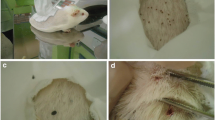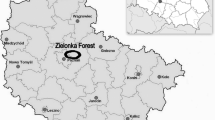Abstract
Rickettsia parkeri, a causative agent of spotted fever rickettsiosis, is transmitted by Amblyomma maculatum (Gulf Coast tick), a tick that may also carry a non-pathogenic spotted fever group Rickettsia, “Candidatus Rickettsia andeanae”. Here, we evaluated R. parkeri and “Candidatus R. andeanae” in tissues from A. maculatum prior to, during, and after blood feeding on rabbits. Using colony-reared A. maculatum that were capillary-fed uninfected cells, R. parkeri, “Candidatus R. andeanae”, or both rickettsiae, we detected higher levels of Rickettsia spp. in the respective treatment groups. Rickettsial levels increased during blood feeding for both R. parkeri and “Candidatus R. andeanae”, with a greater increase in R. parkeri in co-infected ticks compared to singly-infected ticks. We detected transovarial transmission of “Candidatus R. andeanae” in egg and larval cohorts and confirmed vertical transmission of R. parkeri in one group of larvae. Rabbits from all Rickettsia-exposed groups seroconverted on immunofluorescent antibody testing using R. parkeri antigen. Visualization of “Candidatus R. andeanae” in tick salivary glands suggested potential transmission via tick feeding. Here, rickettsial levels in artificially infected ticks demonstrate changes during feeding and transovarial transmission that may be relevant for interpreting rickettsial levels detected in wild A. maculatum.

Similar content being viewed by others
References
Banajee KH, Embers ME, Langohr IM, Doyle LA, Hasenkampf NR, Macaluso KR (2015) Amblyomma maculatum feeding augments Rickettsia parkeri infection in a rhesus macaque model: a pilot study. PLoS One 10:e0135175
Blair PJ, Jiang J, Schoeler GB, Moron C, Anaya E, Cespedes M, Cruz C, Felices V, Guevara C, Mendoza L, Vilaseca P, Sumner JW, Richards AL, Olson JG (2004) Characterization of spotted fever group rickettsiae in flea and tick specimens from northern Peru. J Clin Microbiol 42:4961–4967
Burgdorfer W (1988) Ecological and epidemiological considerations of Rocky Mountain spotted fever and scrub typhus. In: Walker DH (ed) Biology of rickettsial diseases, vol I. CRC Inc., Boca Raton, pp 33–50
Burgdorfer W, Hayes SF, Mavros AJ (1981) Nonpathogenic rickettsiae in Dermacentor andersoni: a limiting factor for the distribution of Rickettsia rickettsii. In: Burgdorfer W, Anacker RL (eds) Rickettsiae and rickettsial diseases. Academic Press Inc., New York, pp 585–594
Burkhardt NY, Baldridge GD, Williamson PC, Billingsley PM, Heu CC, Felsheim RF, Kurtti TJ, Munderloh UG (2011) Development of shuttle vectors for transformation of diverse Rickettsia species. PLoS One 6:e29511
Cragun WC, Bartlett BL, Ellis MW, Hoover ZZ, Tyring SK, Mendoza N, Vento TJ, Nicholson WL, Eremeeva ME, Olano JP, Rapini RP, Paddock CD (2010) The expanding spectrum of eschar-associated rickettsioses in the United States. Arch Dermatol 146:641–648
Ekenna O, Paddock CD, Goddard J (2014) Gulf coast tick rash illness in Mississippi caused by Rickettsia parkeri. J Miss State Med Assoc 55:216–219
Embers ME, Grasperge BJ, Jacobs MB, Phillipp MT (2013) Feeding of ticks on animals for transmission and xenodiagnosis in Lyme disease research. J Vis Exp 78:e50617
Ferrari FAG, Goddard J, Paddock CD, Varela-Stokes AS (2012) Rickettsia parkeri and “Candidatus Rickettsia andeanae” in Gulf Coast ticks, Mississippi, USA. Emerg Infect Dis 18:1705–1707
Ferrari FAG, Goddard J, Moraru GM, Smith WE, Varela-Stokes AS (2013) Isolation of “Candidatus Rickettsia andeanae” (Rickettsiales: Rickettsiaceae) in embryonic cells of naturally infected Amblyomma maculatum (Ixodida: Ixodidae). J Med Entomol 50:1118–1125
Flores-Mendoza C, Florin D, Felices V, Pozo EJ, Graf PC, Burrus RG, Richards AL (2013) Detection of Rickettsia parkeri from within Piura, Peru, and the first reported presence of “Candidatus Rickettsia andeanae” in the tick Rhipicephalus sanguineus. Vector Borne Zoonotic Dis 13:505–508
Goddard J (2003) Experimental infection of lone star ticks, Amblyomma americanum (L.), with Rickettsia parkeri and exposure of guinea pigs to the agent. J Med Entomol 40:686–689
Grasperge BJ, Reif KE, Morgan TD, Sunyakumthorn P, Bynog J, Paddock CD, Macaluso KR (2012) Susceptibility of inbred mice to Rickettsia parkeri. Infect Immun 80:1846–1852
Hauptmann M, Burkhardt N, Munderloh U, Kuehl S, Richardt U, Krasemann S, Hartmann K, Krech T, Fleischer B, Keller C, Osterloh A (2017) GFPuv-expressing recombinant Rickettsia typhi: a useful tool for the study of pathogenesis and CD8 + T cell immunology in R. typhi infection. Infect Immun 85:e00156–e00117
Hayes SF, Burgdorfer W (1979) Ultrastructure of Rickettsia rhipicephali, a new member of the spotted fever group rickettsiae in tissues of the host vector Rhipicephalus sanguineus. J Bacteriol 137:605–613
Kaskas NM, Ledet JJ, Wong A, Muzny CA, Elopre L, Hughey L (2014) Rickettsia parkeri: eschar diagnosis. J Am Acad Dermatol 3:e87–e89
Kocan KM, Yoshioka J, Sonenshine DE, de la Fuente J, Ceraul SM, Blouin EF, Almazan C (2005) Capillary tube feeding system for studying tick-pathogen interactions of Dermacentor variabilis (Acari: Ixodidae) and Anaplasma marginale (Rickettsiales: Anaplasmataceae). J Med Entomol 42:864–874
Lee JK, Moraru GM, Stokes J, Wills R, Mitchell E, Unz E, Moore-Henderson B, Harper AB, Varela-Stokes AS (2017) Rickettsia parkeri and “Candidatus Rickettsia andeanae” in questing Amblyomma maculatum (Gulf Coast tick) from Mississippi. J Med Entomol 54:476–480
Lee JK, Stokes JV, Moraru GM, Harper AB, Smith CL, Wills RW, Varela-Stokes AS (2018) Transmission of Amblyomma maculatum-associated Rickettsia spp. during cofeeding on cattle. Vector Borne Zoonotic Dis. https://doi.org/10.1089/vbz.2017.2228 (ahead of print)
Levin ML, Schumacher LBM, Snellgrove A (2018) Effects of Rickettsia amblyommatis infection on the vector competence of Amblyomma americanum ticks for Rickettsia rickettsii. Vector Borne Zoonotic Dis. https://doi.org/10.1089/vbz.2018.2284 (ahead of print)
Macaluso KR, Sonenshine DE, Ceraul SM, Azad AF (2001) Infection and transovarial transmission of Rickettsiae in Dermacentor variabilis ticks acquired by artificial feeding. Vector Borne Zoonotic Dis 1:45–53
Macaluso KR, Sonenshine DE, Ceraul SM, Azad AF (2002) Rickettsial infection in Dermacentor variabilis (Acari: Ixodidae) inhibits transovarial transmission of a second rickettsia. J Med Entomol 39:809–813
Mays SE, Houston AE, Trout RTT (2016) Specifying pathogen associations of Amblyomma maculatum (Acari: Ixodidae) in Western Tennessee. J Med Entomol 53:435–440
Moraru GM, Goddard J, Paddock CD, Varela-Stokes A (2013) Experimental infection of cotton rats and bobwhite quail with Rickettsia parkeri. Parasit Vectors 6:1–5
Myers T, Lalani T, Dent M, Jiang J, Daly PL, Maguire JD, Richards AL (2013) Detecting Rickettsia parkeri infection from eschar swab specimens. Emerg Infect Dis 19:778–780
Nadolny RM, Wright CL, Sonenshine DE, Hynes WL, Gaff HD (2014) Ticks and spotted fever group rickettsiae of southeastern Virginia. Ticks Tick Borne Dis 5:53–57
Niebylski ML, Schrumpf ME, Burgdorfer W, Fischer ER, Gage KL, Schwan TG (1997) Rickettsia peacockii sp. nov., a new species infecting wood ticks, Dermacentor andersoni, in western Montana. Int J Syst Bacteriol 47:446–452
Nieri-Bastos FA, Szabo MP, Pacheco RC, Soares JF, Soares HS, Moraes-Filho J, Dias RA, Labruna MB (2013) Comparative evaluation of infected and noninfected Amblyomma triste ticks with Rickettsia parkeri, the agent of an emerging rickettsiosis in the New World. BioMed Res Int 2013:1–6
Nieri-Bastos FA, Lopes MG, Cancado PH, Rossa GA, Faccini JL, Gennari SM, Labruna MB (2014) “Candidatus Rickettsia andeanae”, a spotted fever group agent infecting Amblyomma parvum ticks in two Brazilian biomes. Mem Inst Oswaldo Cruz 109:259–261
Paddock CD, Goddard J (2015) The evolving medical and veterinary importance of the Gulf Coast tick (Acari: Ixodidae). J Med Entomol 52:230–252
Paddock CD, Sumner JW, Corner JA, Zaki SR, Goldsmith CS, Goddard J, McLellan SL, Tamminga CL, Ohl CA (2004) Rickettsia parkeri: a newly recognized cause of spotted fever rickettsiosis in the United States. Clin Infect Dis 38:805–811
Paddock CD, Finley RW, Wright CS, Robinson HN, Schrodt BJ, Lane CC, Ekenna O, Blass MA, Tamminga CL, Ohl CA, McLellan SL, Goddard J, Holman RC, Openshaw JJ, Sumner JW, Zaki SR, Eremeeva ME (2008) Rickettsia parkeri rickettsiosis and its clinical distinction from Rocky Mountain spotted fever. Clin Infect Dis 47:1188–1196
Paddock CD, Fournier PE, Sumner JW, Goddard J, Elshenawy Y, Metcalfe MJ, Loftis AD, Varela-Stokes A (2010) Isolation of Rickettsia parkeri and identification of a novel spotted fever group Rickettsia sp. from Gulf Coast ticks (Amblyomma maculatum) in the United States. Appl Environ Microbiol 76:2689–2696
Paddock CD, Denison AM, Dryden MW, Noden BH, Lash RR, Abdelghani SS, Evans AE, Kelly AR, Hecht JA, Karpathy SE, Ganta RR, Little SE (2015) High prevalence of “Candidatus Rickettsia andeanae” and apparent exclusion of Rickettsia parkeri in adult Amblyomma maculatum (Acari: Ixodidae) from Kansas and Oklahoma. Ticks Tick Borne Dis 6:297–302
Philip RN, Casper EA (1981) Serotypes of spotted fever group rickettsiae isolated from Dermacentor andersoni (Stiles) ticks in western Montana. Am J Trop Med Hyg 30:230–238
Silverman DJ, Wisseman CL Jr, Waddell AD, Jones M (1978) External layers of Rickettsia prowazekii and Rickettsia rickettsii: occurrence of a slime layer. Infect Immun 22:233–246
Stothard DR, Clark JB, Fuerst PA (1994) Ancestral divergence of Rickettsia bellii from the spotted fever and typhus groups of Rickettsia and antiquity of the genus Rickettsia. Int J Syst Bacteriol 44:798–804
Straily A, Feldpausch A, Ulbrich C, Schell K, Casillas S, Zaki S, Denison AM, Condit ME, Gabel J, Paddock CD (2016) Rickettsia parkeri Rickettsiosis—Georgia, 2012–2014. Morb Mortal Wkly Rep 65:718–719
Sumner JW, Durden LA, Goddard J, Stromdahl EY, Clark KL, Reeves WK, Paddock CD (2007) Gulf Coast ticks (Amblyomma maculatum) and Rickettsia parkeri, United States. Emerg Infect Dis 13:751–753
Varela-Stokes AS, Paddock CD, Engber B, Toliver M (2011) Rickettsia parkeri in Amblyomma maculatum ticks, North Carolina, USA, 2009–2010. Emerg Infect Dis 17:2350–2353
Wright CL, Nadolny RM, Jiang J, Richards AL, Sonenshine DE, Gaff HD, Hynes WL (2011) Rickettsia parkeri in Gulf Coast Ticks, Southeastern Virginia, USA. Emerg Infect Dis 17:896–898
Wright CL, Sonenshine DE, Gaff HD, Hynes WL (2015a) Rickettsia parkeri transmission to Amblyomma americanum by cofeeding with Amblyomma maculatum (Acari: Ixodidae) and potential for spillover. J Med Entomol 52:1090–1095
Wright CL, Gaff HD, Soneshine DE, Hynes WL (2015b) Experimental vertical transmission of Rickettsia parkeri in the Gulf Coast tick, Amblyomma maculatum. Ticks Tick Borne Dis 6:568–573
Acknowledgements
Funding for this work was provided from the National Institutes of Health (NIH) 1R15A 1099928-01A1, which supported design of the study and collection, analysis, and interpretation of data and in writing the manuscript. The A.V.S. laboratory was also supported in part by NIH COBRE P20GM103646 during this study. We thank all staff of the LARAC, especially Ms. Jamie Walker for critical care, all animal assistance, and support for this project. We appreciate laboratory assistance from Katie Graham and Jacob Hughes.
Author information
Authors and Affiliations
Corresponding author
Additional information
Publisher’s Note
Springer Nature remains neutral with regard to jurisdictional claims in published maps and institutional affiliations.
Rights and permissions
About this article
Cite this article
Lee, J.K., Moraru, G.M., Stokes, J.V. et al. Amblyomma maculatum-associated rickettsiae in vector tissues and vertebrate hosts during tick feeding. Exp Appl Acarol 77, 187–205 (2019). https://doi.org/10.1007/s10493-019-00343-x
Received:
Accepted:
Published:
Issue Date:
DOI: https://doi.org/10.1007/s10493-019-00343-x




